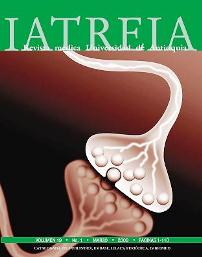Frequency of urinary tract infections in febrile infants without evidence of an infectious source. from the clinic of the Unidad Vida Infantil of the University of Antioquia, Hospital Francisco Valderrama, Turbo, Colombia.
DOI:
https://doi.org/10.17533/udea.iatreia.4260Keywords:
Infección urinaria (ITU), Lactante febril, Síndrome febril agudo, ACUTE FEBRILE SYNDROME, FEBRILE YOUNG CHILDREN, URINARY TRACT INFECTION (UTI)Abstract
BACKGROUND: in infants, it has been documented that urinary tract infections (UTI) are a common cause of the acute febrile syndrome without apparent source for the fever. According to the results of some research, the prevalence of UTI varies between 4% and 13%. In infants, especially those under the age of 2 years, UTI are associated with an increased incidence of vesicoureteral reflux and renal parenchymal involvement. Moreover, this group of patients with UTI require special attention in order to prevent renal scarring, hypertension and chronic renal failure. OBJECTIVE: to establish the prevalence rate of UTI in febrile infants under 24 months of age, admitted to the Vida Infantil” Department of the University of Antioquia and the Francisco Valderrama Hospital in Turbo, Antioquia, (Colombia), from February 1st, 2003 through January 31st, 2004. METHODS: a total of 50 children under 24 months of age who had been admitted to the aforementioned Department were enrolled in this prospective study. Patients had fever the cause of which was not definitely known. The following laboratory tests were performed: white blood cell total and differential count (WBC), erythrocyte sedimentation rate (ESR), urine dipstick tests for leukocyte esterase and nitrites, urinalysis (UA) (urine white blood cell count/mm3), gram stain in a drop of uncentrifuged urine, microscopic UA (white blood cells and bacteria per high-powered field), and quantitative urine culture (positive urine results were defined as ³104 colony-forming units of an urinary tract pathogen per mL). All urine specimens were obtained by urethral catheterization. Sensitivity, specificity, and accuracy likelihood ratios were determined for each one of the screening tests. RESULTS: overall prevalence of UTI (growth of >104 CFU of an urinary tract pathogen per mL) was 10%. Average age was 7 months. Most children with UTI had anorexia, irritability, general malaise, and vomiting. The most specific laboratory parameters were urine positive gram stain (any bacteria), and pyuria (>10 WBC/high-powered field). All urinary tract infections were caused by Escherichia coli. Isolates of this urinary pathogen showed decreased susceptibility to trimetoprimsulfametoxasole, as well as resistance to ampicillin. CONCLUSIONS: UTI is a frequent cause of the acute febrile syndrome without apparent source for the fever in infants of Turbo, Antioquia. In such cases, particularly when there are not specific clinical signs or symptoms, physicians should take this disease into consideration, and order an UA (white blood cells and bacteria per high-powered field), and gram stain. If results of these tests are positive, an urine culture becomes necessary. In our study, E. coli isolates showed significant resistance to commonly prescribed antibiotics.
|Abstract = 612 veces
|
PDF (ESPAÑOL (ESPAÑA)) = 136 veces|
Downloads
Download data is not yet available.
Downloads
Published
2006-01-02
How to Cite
1.
Aguirre Jaramillo OH, Jiménez Soto MF, Cornejo Ochoa JW, Botero López JE, Zapata Muñoz CT, Durango Galván H, Bernal Parra CA. Frequency of urinary tract infections in febrile infants without evidence of an infectious source. from the clinic of the Unidad Vida Infantil of the University of Antioquia, Hospital Francisco Valderrama, Turbo, Colombia. Iatreia [Internet]. 2006 Jan. 2 [cited 2025 Dec. 5];19(1):pág. 29-38. Available from: https://revistas.udea.edu.co/index.php/iatreia/article/view/4260
Issue
Section
Original research
License
Papers published in the journal are available for use under the Creative Commons license, specifically Attribution-NonCommercial-ShareAlike 4.0 International.
The papers must be unpublished and sent exclusively to the Journal Iatreia; the author uploading the contribution is required to submit two fully completed formats: article submission and authorship responsibility.














